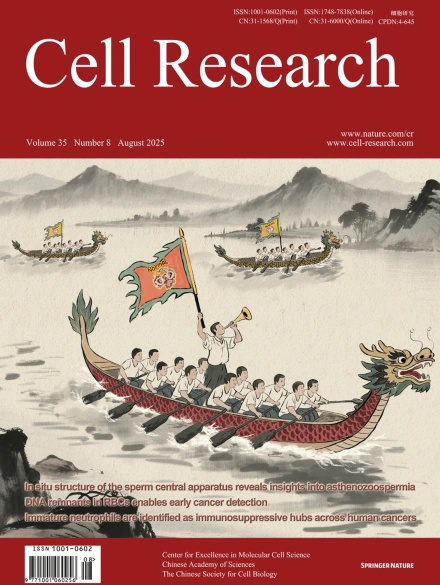
Advanced Search
Submit Manuscript
Advanced Search
Submit Manuscript
Volume 35, No 8, Aug 2025
ISSN: 1001-0602
EISSN: 1748-7838 2018
impact factor 17.848*
(Clarivate Analytics, 2019)
Volume 35 Issue 8, August 2025: 551-567 |
In situ structure of the mouse sperm central apparatus reveals mechanistic insights into asthenozoospermia
Yun Zhu1,†,* , Tingting Lin2,3,† , 1,4,* , Linhua Tai1,4 , Lianwan Chen1 , Jing Ma2,3 , Guoning Huang2,3 , Yi Lu5 , Zhiyong Zhang5,6 , Binbin Wang7,8,9 , Suren Chen10,* , Fei Sun1,4,11,12,*
1National Laboratory of Biomacromolecules, Institute of Biophysics, Chinese Academy of Sciences, Beijing, ChinaThe central apparatus (CA) within the sperm axoneme is vital for sperm motility, yet its molecular architecture and functional mechanisms remain incompletely understood. Combining cryo-electron tomography and AlphaFold2, we resolved the in-cell structure of mouse sperm CA at a subnanometer resolution and built a near-complete atomic model. Our analysis identified 39 CA-associated proteins, including eight previously unreported components. By presenting the full-length structures of CFAP47 and HYDIN, we elucidate their molecular roles in tethering the C1 and C2 microtubules within the CA. Specifically, HYDIN forms a semicircular chain that encircles C1 and C2, with its N-terminal half driving the C1–C2 connection and its C-terminal half providing axial support in C2. CFAP47, the core structural component of the bridge, binds C1 through its N-terminal domains, interacts with HYDIN via its central CFAP47-ring, and anchors to C2 through its C-terminal region. The significantly reduced sperm motility and impaired CA structure observed in Cfap47-knockout mice confirmed the important role of CFAP47. Furthermore, genetic analysis of infertile Chinese men with asthenozoospermia identified previously unreported mutations in the CFAP47. The CA structural model elucidates the pathogenic mechanisms of these mutations, establishing a direct link between CFAP47 dysfunction and impaired sperm motility. Therefore, our study provides mechanistic insights into CA-related fertility disorders.
https://doi.org/10.1038/s41422-025-01135-2